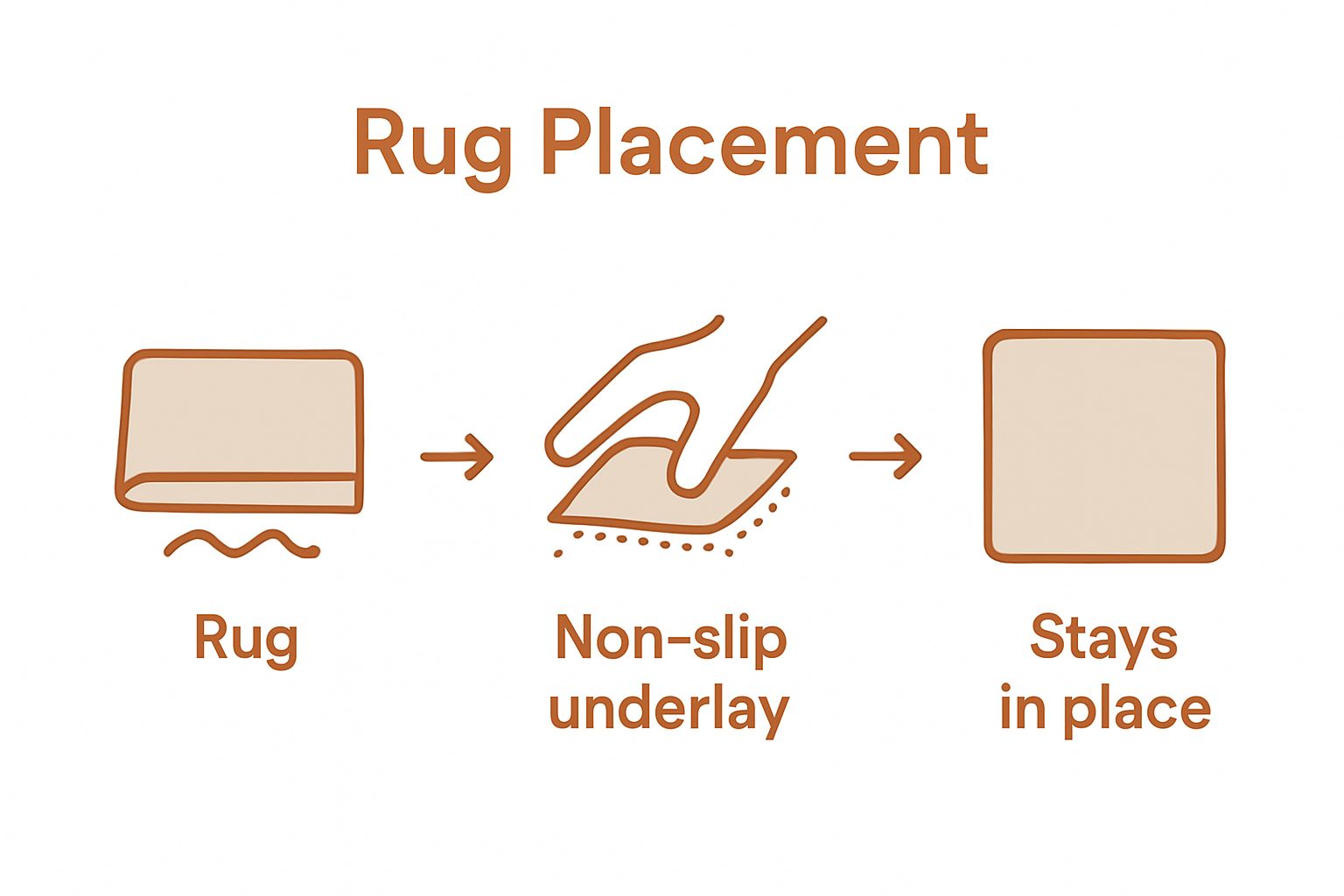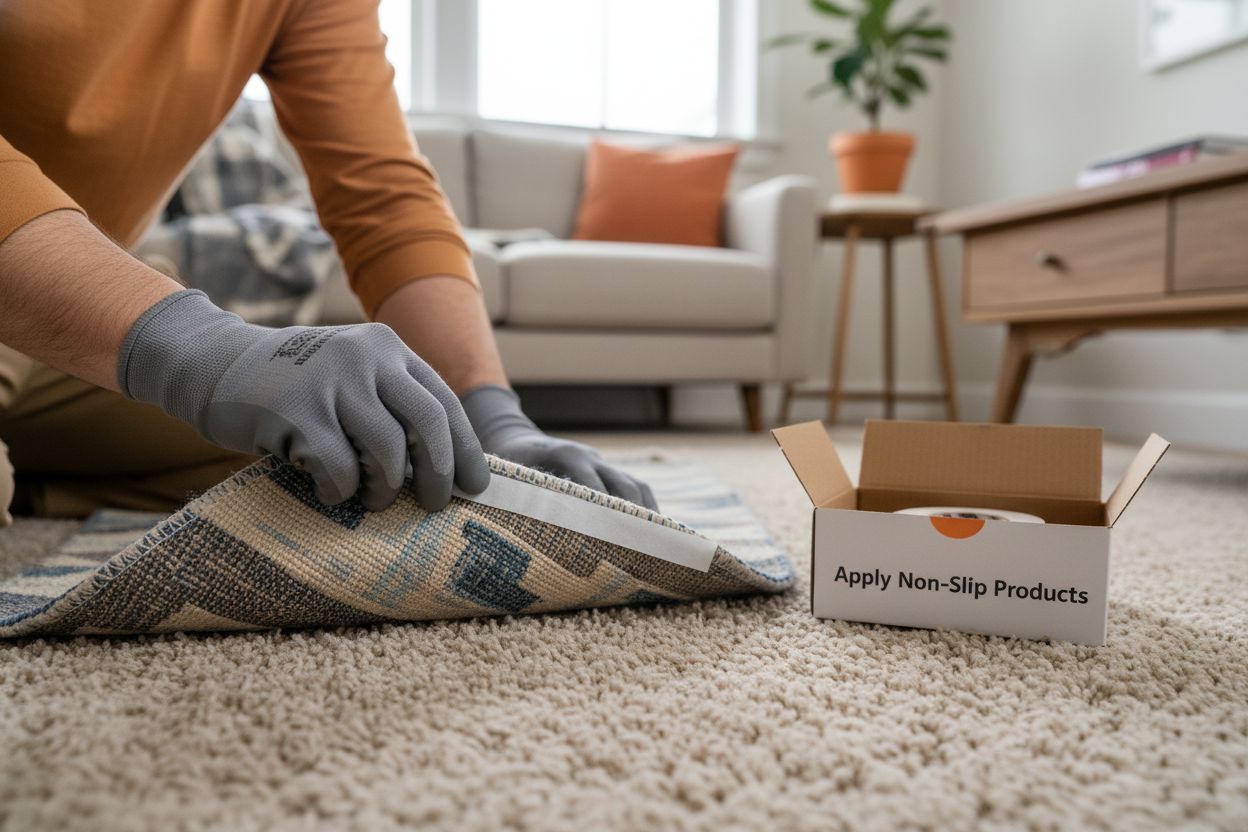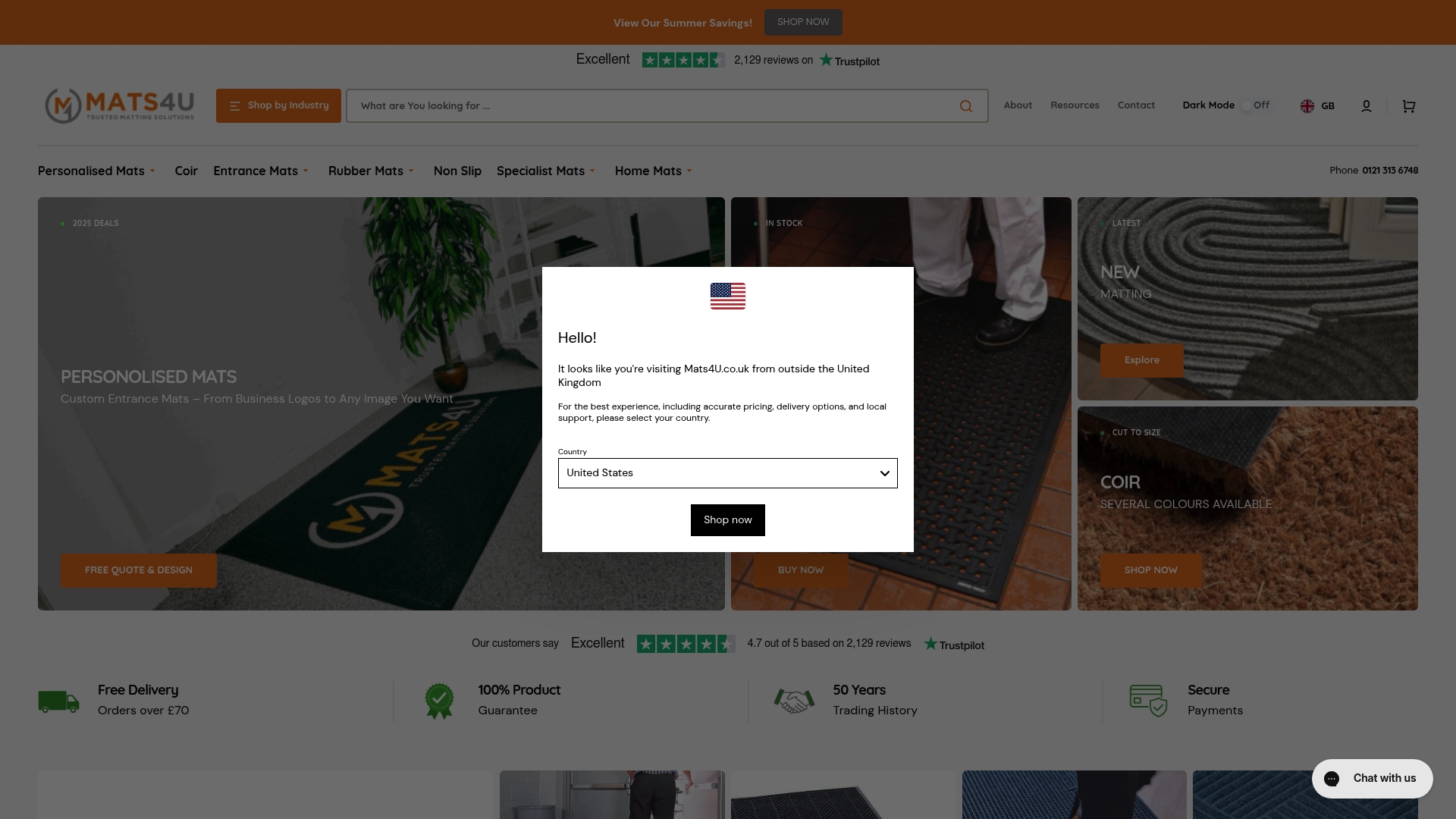Struggling to keep your rug from skidding across the carpet every time someone walks past? It may come as a shock that even a plush, expensive rug can shuffle out of place just as easily as a budget one. But what truly surprises most people is that the type of carpet beneath your rug can be the biggest culprit, not the rug itself. There are proven ways to stop this annoyance for good, and the simplest solutions often work better than you would expect.
Table of Contents
- Step 1: Evaluate Your Carpet And Rug Combination
- Step 2: Select Appropriate Non-Slip Solutions
- Step 3: Apply Non-Slip Products Or Techniques
- Step 4: Test The Stability Of Your Rugs
- Step 5: Maintain And Monitor Rug Positioning
Quick Summary
| Key Point | Explanation |
|---|---|
| 1. Evaluate carpet and rug specifics. | Understanding texture, pile height, and materials helps in selecting effective non-slip solutions. |
| 2. Choose non-slip products wisely. | Select products like rubber underlays or double-sided tape that suit your carpet and rug combination. |
| 3. Apply solutions meticulously. | Ensure surfaces are clean and follow application steps precisely for maximum stability. |
| 4. Conduct thorough stability tests. | Walk across rugs and simulate various movements to check for any slipping or shifting. |
| 5. Monitor and maintain regularly. | Schedule inspections to check rug positioning and clean non-slip products to retain effectiveness. |
Step 1: Evaluate Your Carpet and Rug Combination
Successfully stopping rugs from moving on carpet starts with a careful and strategic evaluation of your specific floor covering environment. Understanding the unique characteristics of both your carpet and rug is crucial in developing an effective stabilisation strategy.
Begin by thoroughly examining your carpet’s texture and pile height. Carpets with short, dense pile or tightly woven Berber styles will behave differently from plush or high pile carpets. Smooth, low pile carpets tend to create less friction, making rug movement more likely. Conversely, textured carpets with longer fibres naturally provide more grip, which can help minimise unwanted mat migration.
Next, assess your rug’s material and backing. Natural fibre rugs like wool or cotton typically have more slip potential compared to synthetic options with rubberised or textured backings. Lightweight rugs constructed from smooth materials such as silk or fine cotton will require more intervention to prevent sliding, whereas heavier woollen or thick cotton rugs might inherently possess more stability.
Measure both your carpet and rug dimensions precisely. Understanding the relative sizes helps determine which stabilisation techniques will work most effectively. For smaller rugs placed in high traffic areas like hallways or entranceways, more aggressive securing methods might be necessary. Larger area rugs covering substantial carpet sections might require a more nuanced approach.
Key evaluation criteria to consider:
- Carpet pile height and texture
- Rug material composition
- Backing type and surface friction
- Room traffic intensity
- Rug placement and potential movement zones
Careful observation and documentation of these factors will provide a solid foundation for selecting the most appropriate rug stabilisation technique.
By taking the time to thoroughly understand your specific carpet and rug combination, you’ll be well prepared to implement targeted solutions that effectively prevent unwanted mat movement.
Step 2: Select Appropriate Non-Slip Solutions
Selecting the right non-slip solution transforms your approach to preventing rug movement and protects both your carpet and floor covering investment. Your evaluation from the previous step will directly inform the most suitable stabilisation method for your specific carpet and rug combination.
Rug underlay and gripping products represent the primary defensive strategy against unwanted mat migration. Manufacturers have developed multiple solutions catering to different carpet types and room environments. Rubber-backed rug grips, felt underlays, and adhesive solutions each offer unique advantages depending on your specific requirements.
Professional grade double-sided carpet tape provides an excellent temporary solution for smaller rugs and runners.
 These specialist tapes create a secure bond between carpet and rug without causing permanent damage. Look for tape specifically designed for carpet use, which allows for clean removal without leaving residue. Carpet tape works particularly well in high traffic areas like hallways, entrances, and living spaces where frequent rug movement occurs.
These specialist tapes create a secure bond between carpet and rug without causing permanent damage. Look for tape specifically designed for carpet use, which allows for clean removal without leaving residue. Carpet tape works particularly well in high traffic areas like hallways, entrances, and living spaces where frequent rug movement occurs.
For larger area rugs, specialized non-slip underlay materials offer superior protection. Thick, textured underlays made from materials like natural rubber or synthetic gripping compounds create friction that prevents sliding. These underlays distribute weight evenly and provide additional cushioning, which not only stabilises your rug but also enhances comfort and reduces wear on your carpet.
Critical considerations when selecting non-slip solutions:
- Compatibility with your specific carpet pile
- Room temperature and humidity levels
- Expected foot traffic intensity
- Rug size and weight
- Potential for permanent carpet marking
When choosing your non-slip solution, prioritise products that offer a balance between effectiveness and carpet preservation. Explore our guide on rubber-backed mat solutions for more detailed insights into selecting the most appropriate stabilisation method for your unique flooring environment. Remember that no single solution works universally, so be prepared to experiment and adjust your approach based on initial results.
The following table compares popular non-slip rug solutions to help you choose the most suitable method for your carpet and rug combination.
| Non-Slip Solution | Best For | Key Advantages | Potential Drawbacks |
|---|---|---|---|
| Rubber Underlay | Large area rugs | Excellent grip, easy to reposition | Can be bulky under thinner rugs |
| Double-Sided Carpet Tape | Runners, small rugs, high traffic | Strong adhesion, simple to apply | May need periodic replacement |
| Felt Underlay with Grip | Plush carpets, comfort required | Extra cushioning, preserves carpet fibres | May be less effective on thick pile |
| Rubber-Backed Rug Grippers | Lightweight rugs, corners | Prevents lifting edges, easy to install | May not suit all rug types |
| Adhesive Rug Pads | Temporary fixes | Quick application, minimal bulk | Adhesive may degrade over time |
Step 3: Apply Non-Slip Products or Techniques
Applying non-slip solutions requires precision, patience, and a methodical approach to ensure maximum effectiveness and minimal carpet disruption. The techniques you select will directly impact the stability and longevity of your floor coverings.
Clean and prepare your carpet surface thoroughly before applying any non-slip product. Vacuum the carpet meticulously to remove dust, debris, and loose fibres that could interfere with adhesion. Use a clean, dry cloth to eliminate any remaining surface moisture or residue. This preparation stage is critical for ensuring optimal product performance and preventing potential damage to your carpet fibres.

When applying carpet tape, work systematically and carefully. Cut the tape into precise strips that match your rug’s dimensions, leaving a small margin around the edges. Press the tape firmly and evenly, ensuring no air bubbles or wrinkles develop. Start from the centre of the rug and work outwards, using a smooth, flat tool like a credit card to eliminate potential gaps or uneven areas. For larger rugs, consider using multiple strips to distribute weight and prevent potential tape failure.
Rug grippers and non-slip underlays require slightly different application techniques. Position the underlay centrally on your carpet, ensuring it is completely flat and smooth. Gently place your rug on top, applying light pressure to create a secure bond. Learn more about anti-slip mat benefits for various environments to understand the broader implications of your chosen stabilisation method.
Key application verification points:
- Ensure complete surface contact between rug and non-slip solution
- Check for any visible gaps or loose edges
- Test rug stability by walking across different sections
- Confirm no residue or damage to carpet fibres
- Verify the rug remains stationary under normal usage conditions
Remember that some solutions might require periodic reapplication or adjustment. Monitor your rug’s performance over time and be prepared to readjust or replace non-slip products as needed. Different rooms and traffic patterns will influence the longevity and effectiveness of your chosen stabilisation technique.
Step 4: Test the Stability of Your Rugs
Testing the stability of your rugs represents the critical verification stage that confirms the effectiveness of your non-slip solutions. This step ensures that your chosen methods actually prevent unwanted mat movement and protect your carpeted surfaces.
Begin your stability testing with a systematic walking pattern across the entire rug surface. Walk naturally, varying your stride and applying different levels of pressure to simulate realistic household movement. Pay close attention to how the rug responds during turns, quick movements, and when multiple people traverse the surface simultaneously. A stable rug should remain firmly in place without any noticeable shifting or bunching.
Carry out comprehensive movement tests in different scenarios. Walk diagonally across the rug, simulate turning movements, and deliberately apply slightly more aggressive walking patterns to assess the non-slip solution’s durability. Focus on high traffic zones and areas where rugs are most likely to experience substantial movement. Observe whether the rug maintains its original position or if any slight movements occur that might compromise its stability.
Explore our comprehensive guide to preventing mat movement for additional insights into advanced stabilisation techniques. Understanding the nuanced approaches to rug security can help you refine your chosen method and ensure long-term success.
Critical testing verification points:
- No visible sliding or shifting during walking
- Consistent positioning before and after movement
- Even weight distribution across the entire rug
- No bunching or wrinkling of carpet or rug
- Maintained grip under various walking intensities
If your initial test reveals any instability, do not become discouraged. Reassess your non-slip product application, potentially reapplying the solution or trying an alternative method. Some rugs may require multiple attempts or combinations of stabilisation techniques to achieve optimal results. Patience and methodical testing are key to creating a secure, safe floor covering environment.
Step 5: Maintain and Monitor Rug Positioning
Maintaining and monitoring rug positioning represents the final and ongoing stage of ensuring long-term carpet protection and mat stability. This critical step transforms your initial stabilisation efforts into a sustainable solution that preserves both your floor coverings and non-slip interventions.
Regular inspection forms the cornerstone of effective rug maintenance. Schedule monthly visual and physical assessments of your rug’s positioning, paying close attention to potential signs of movement, wear, or degradation of your non-slip solutions. Look for subtle indicators such as slight edge lifting, corner curling, or microscopic shifts that might signal the need for intervention. These early warning signs can help you address potential issues before they escalate into more significant problems.
Clean your non-slip products and rugs periodically to maintain their effectiveness. Dust, dirt, and accumulated debris can gradually reduce the grip of carpet tape, rug grippers, and underlays. Explore our commercial mat cleaning techniques to understand the best practices for preserving your floor coverings. Vacuum both the carpet and rug surface carefully, and use appropriate cleaning methods that do not compromise the adhesive properties of your chosen stabilisation method.
Rotate and realign rugs systematically to ensure even wear and prevent permanent carpet indentations. This practice not only maintains the aesthetic appeal of your floor coverings but also helps distribute weight and friction more evenly. Consider moving rugs slightly every few months, even if only by a few centimetres, to prevent colour fading and fibre compression in specific areas.
Key maintenance verification points:
- No visible rug movement during normal usage
- Consistent adhesion of non-slip products
- Even carpet and rug surface appearance
- No signs of wear or damage to carpet fibres
- Maintained grip strength of stabilisation solutions
Remember that environmental factors like humidity, temperature fluctuations, and foot traffic can impact your rug’s stability over time. Be prepared to reassess and potentially reapply your non-slip solutions periodically.
Use this table as a checklist to verify your rug is properly stabilised and maintained over time for optimal safety and appearance.
| Verification Task | Pass Criteria | Frequency |
|---|---|---|
| Check for visible sliding or shifting | Rug remains stationary during normal walking | Monthly |
| Inspect non-slip product adhesion | No peeling, lifting, or residue on surfaces | Monthly |
| Examine for carpet or rug damage | No visible wear, indentations, or fibre pulls | Monthly |
| Rotate and realign rug | Rug orientation changed slightly to prevent permanent marking | Every few months |
| Clean rug and non-slip solutions | No dirt build-up; grip remains effective | As needed |
| Reassess under varied conditions | Rug remains secure despite foot traffic and environmental shifts | Every few months |
Keep Every Rug in Its Place – Protect Your Carpet with Mats4U Solutions
Have you found yourself frustrated by rugs that never seem to stay put on carpeted floors? The struggle to keep mats in place not only affects aesthetics but also poses a real safety hazard in busy areas. After learning how different carpet textures, rug backings, and room usage can all contribute to unwanted rug movement, you are now one step closer to a stable and attractive space. You deserve peace of mind knowing your rugs stay secure, protect your carpet, and enhance comfort for everyone.

Why let moving rugs become a persistent problem? Explore our range of anti-slip mats and non-slip underlay solutions specifically crafted for homes and businesses across the UK. At Mats4U, you will find made-to-measure mats, commercial entrance mats, and specialist floor protection designed to solve the very challenges discussed in this article. For tailored advice or to see our customisation options, contact our experts or view our resource section for practical tips. Take action now and discover a safer, smarter approach to securing your rugs at Mats4U – because your floors deserve the best.
Frequently Asked Questions
How can I evaluate my carpet and rug combination to stop rugs moving on carpet?
To effectively stop rugs from moving, start by assessing your carpet’s texture and pile height, as well as your rug’s material and backing. Document these characteristics, as they will inform your choice of stabilisation methods.
What non-slip solutions can I use to secure my rugs on carpet?
Use specialised rug underlays, rubber-backed grippers, or professional grade double-sided carpet tape to secure your rugs. Choose a solution that fits your rug size and carpet type for optimal results.
How do I apply non-slip products to prevent rug movement?
Begin by cleaning your carpet thoroughly before applying non-slip products. When using carpet tape or an underlay, ensure they are evenly placed and pressed down without gaps to maximise grip.
How can I test the stability of my rugs after applying non-slip solutions?
Walk naturally across your rug after applying the non-slip solution to check for movement. Ensure there’s no noticeable shifting or bunching under your weight, which indicates a secure setup.
What should I do to maintain rug positioning over time?
Perform regular inspections of your rug every month to check for signs of movement or wear. Clean your non-slip products and periodically rotate your rugs to ensure even wear and longevity.
How often should I reassess my non-slip solutions?
Reassess your non-slip solutions every few months or sooner if you notice instability. Environmental factors like humidity and foot traffic can impact effectiveness, so be prepared to adjust as needed.









